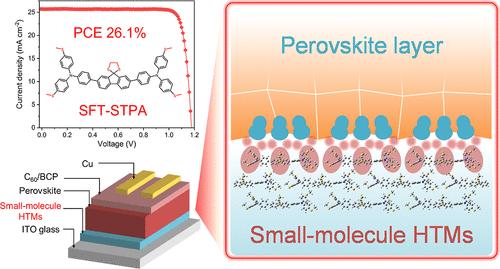26%高效倒置钙钛矿太阳能电池的小分子空穴传输材料
IF 15.6
1区 化学
Q1 CHEMISTRY, MULTIDISCIPLINARY
引用次数: 0
摘要
可化学修饰的小分子空穴传输材料(HTMs)有望实现高效、可扩展的过氧化物太阳能电池(PSCs)。与新兴的自组装单层材料相比,小分子空穴传输材料在大面积沉积和长期运行稳定性方面更为可靠。然而,目前倒置 PSC 中的小分子 HTM 缺乏兼顾电荷传输能力和界面兼容性的高效分子设计,导致功率转换效率(PCE)长期停滞在 24.5% 以下。在此,我们报告了 HTMs 主干和官能团的综合设计,优化了具有超过 7.1 × 10-4 cm2 V-1 S-1 高迁移率的简单平面线性分子主干,并增强了其界面锚定能力。由于改善了表面特性和锚定效应,定制的 HTM 增强了 HTM/过氧化物异质结的界面接触,最大限度地减少了非辐射重组和传输损耗,使填充因子高达 86.1%。我们的工作克服了小分子 HTM(尤其是大面积器件)长期存在的效率瓶颈。因此,在 0.068 平方厘米的器件和 1.008 平方厘米的器件中,所产生的 PSC 的 PCE 分别为 26.1%(经认证为 25.7%)和 24.7%(经认证为 24.4%),代表了倒置 PSC 中小分子 HTM 的最高 PCE。本文章由计算机程序翻译,如有差异,请以英文原文为准。

Small-Molecule Hole Transport Materials for >26% Efficient Inverted Perovskite Solar Cells
Chemically modifiable small-molecule hole transport materials (HTMs) hold promise for achieving efficient and scalable perovskite solar cells (PSCs). Compared to emerging self-assembled monolayers, small-molecule HTMs are more reliable in terms of large-area deposition and long-term operational stability. However, current small-molecule HTMs in inverted PSCs lack efficient molecular designs that balance both the charge transport capability and interface compatibility, resulting in a long-standing stagnation of power conversion efficiency (PCE) below 24.5%. Here, we report the comprehensive design of HTMs’ backbone and functional groups, which optimizes a simple planar linear molecular backbone with a high mobility exceeding 7.1 × 10–4 cm2 V–1 S–1 and enhances its interface anchoring capability. Owing to the improved surface properties and anchoring effects, the tailored HTMs enhance the interface contact at the HTM/perovskite heterojunction, minimizing nonradiative recombination and transport loss and leading to a high fill factor of 86.1%. Our work has overcome the persistent efficiency bottleneck for small-molecule HTMs, particularly for large-area devices. Consequently, the resultant PSCs exhibit PCEs of 26.1% (25.7% certified) for a 0.068 cm2 device and 24.7% (24.4% certified) for a 1.008 cm2 device, representing the highest PCE for small-molecule HTMs in inverted PSCs.
求助全文
通过发布文献求助,成功后即可免费获取论文全文。
去求助
来源期刊
CiteScore
24.40
自引率
6.00%
发文量
2398
审稿时长
1.6 months
期刊介绍:
The flagship journal of the American Chemical Society, known as the Journal of the American Chemical Society (JACS), has been a prestigious publication since its establishment in 1879. It holds a preeminent position in the field of chemistry and related interdisciplinary sciences. JACS is committed to disseminating cutting-edge research papers, covering a wide range of topics, and encompasses approximately 19,000 pages of Articles, Communications, and Perspectives annually. With a weekly publication frequency, JACS plays a vital role in advancing the field of chemistry by providing essential research.

 求助内容:
求助内容: 应助结果提醒方式:
应助结果提醒方式:


